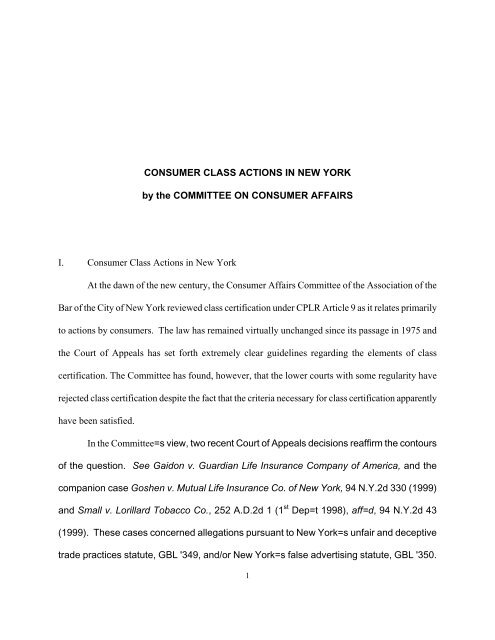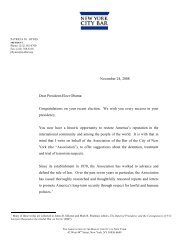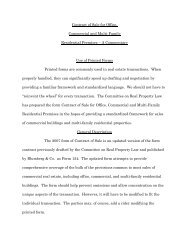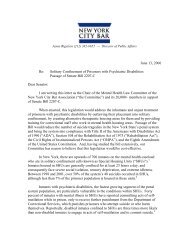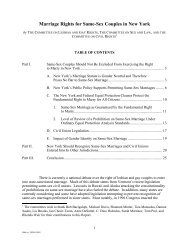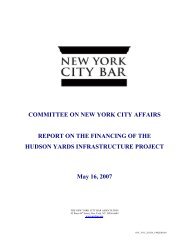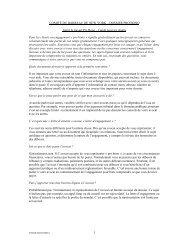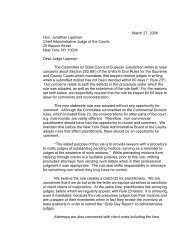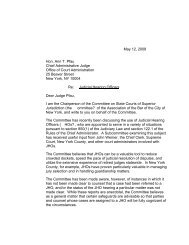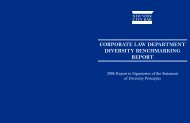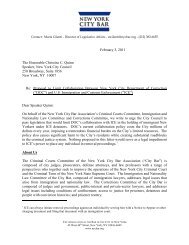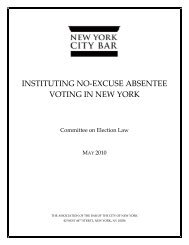Consumer Class Actions in New York - New York City Bar Association
Consumer Class Actions in New York - New York City Bar Association
Consumer Class Actions in New York - New York City Bar Association
Create successful ePaper yourself
Turn your PDF publications into a flip-book with our unique Google optimized e-Paper software.
CONSUMER CLASS ACTIONS IN NEW YORK<br />
by the COMMITTEE ON CONSUMER AFFAIRS<br />
I. <strong>Consumer</strong> <strong>Class</strong> <strong>Actions</strong> <strong>in</strong> <strong>New</strong> <strong>York</strong><br />
At the dawn of the new century, the <strong>Consumer</strong> Affairs Committee of the <strong>Association</strong> of the<br />
<strong>Bar</strong> of the <strong>City</strong> of <strong>New</strong> <strong>York</strong> reviewed class certification under CPLR Article 9 as it relates primarily<br />
to actions by consumers. The law has rema<strong>in</strong>ed virtually unchanged s<strong>in</strong>ce its passage <strong>in</strong> 1975 and<br />
the Court of Appeals has set forth extremely clear guidel<strong>in</strong>es regard<strong>in</strong>g the elements of class<br />
certification. The Committee has found, however, that the lower courts with some regularity have<br />
rejected class certification despite the fact that the criteria necessary for class certification apparently<br />
have been satisfied.<br />
In the Committee=s view, two recent Court of Appeals decisions reaffirm the contours<br />
of the question. See Gaidon v. Guardian Life Insurance Company of America, and the<br />
companion case Goshen v. Mutual Life Insurance Co. of <strong>New</strong> <strong>York</strong>, 94 N.Y.2d 330 (1999)<br />
and Small v. Lorillard Tobacco Co., 252 A.D.2d 1 (1 st Dep=t 1998), aff=d, 94 N.Y.2d 43<br />
(1999). These cases concerned allegations pursuant to <strong>New</strong> <strong>York</strong>=s unfair and deceptive<br />
trade practices statute, GBL '349, and/or <strong>New</strong> <strong>York</strong>=s false advertis<strong>in</strong>g statute, GBL '350.<br />
1
They make pla<strong>in</strong> that where liability can be established uniformly and at once for all class<br />
members, a class action will serve as the superior method of adjudication; where liability<br />
turns on whether a particular product, statement, or event <strong>in</strong>jured a class member,<br />
<strong>in</strong>dividual issues may predom<strong>in</strong>ate and class treatment of the underly<strong>in</strong>g claim may be<br />
unmanageable and <strong>in</strong>efficient. These pr<strong>in</strong>ciples apply equally to consumer claims for<br />
breach of warranty, breach of contract, fraud, negligent misrepresentation, and breach of<br />
fiduciary duty.<br />
The Committee notes that <strong>in</strong> one area of importance to consumers, the enforcement<br />
of <strong>New</strong> <strong>York</strong>=s antitrust laws, several trial level courts have denied class treatment to<br />
claims asserted under the Donnelly Act, GBL '340. These courts have denied class<br />
treatment of Donnelly Act claims on the grounds that the treble damage remedy provided<br />
for <strong>in</strong> the Donnelly Act is a penalty and the CPLR precludes certification of any action<br />
seek<strong>in</strong>g a penalty. It is the Committee=s view that the treble damage remedy is not a<br />
penalty and therefore these decisions were <strong>in</strong>correctly decided.<br />
Application of Article 9 <strong>in</strong> a manner consistent with its <strong>in</strong>tent and controll<strong>in</strong>g case law<br />
will improve the quality of justice <strong>in</strong> <strong>New</strong> <strong>York</strong>. This report will exam<strong>in</strong>e the history of the<br />
statute and will give examples of cases that apply, and that appear to deviate from,<br />
controll<strong>in</strong>g pr<strong>in</strong>ciples.<br />
2
II. History of CPLR Article 9<br />
The class action has long been recognized as an important procedural device for the<br />
consumer to seek redress of grievances <strong>in</strong> a matter <strong>in</strong> which the damages suffered may not justify<br />
the cost of <strong>in</strong>dividual litigation. 1<br />
<strong>New</strong> <strong>York</strong>=s orig<strong>in</strong>al class action rule, CPLR '1005, set forth the standards for a<br />
proper class action <strong>in</strong> broad terms:<br />
Where the question is one of a common or general <strong>in</strong>terest of<br />
many persons or where the persons who might be made<br />
parties are very numerous and it may be impracticable to br<strong>in</strong>g<br />
them all before the court, one or more may sue or defend for<br />
the benefit of all.<br />
Yet, <strong>New</strong> <strong>York</strong> courts consistently <strong>in</strong>terpreted the statute narrowly to require a Aunity<br />
of <strong>in</strong>terest@ among the class members. Hall v. Coburn Corp., 26 N.Y.2d 396, 398 (1970).<br />
Courts conf<strong>in</strong>ed the relief available under CPLR §1005 to controversies <strong>in</strong>volv<strong>in</strong>g either a<br />
limited fund or specific property as to which the members of the class were united by<br />
Aprivity@ or where the relief sought either automatically satisfied the claims of all or was<br />
<strong>in</strong>junctive <strong>in</strong> nature. Where the controversy <strong>in</strong>volved the predom<strong>in</strong>ance of common<br />
questions of law or fact rather than questions affect<strong>in</strong>g particular members of the class --<br />
1<br />
The Committee previously wrote that A[t]he s<strong>in</strong>gle most important obstacle<br />
for the aggrieved consumer is the disproportion between the amount of his claim and<br />
the cost of enforc<strong>in</strong>g that claim.@ See The Record, 1973 Committee Report<br />
3
and this is the norm <strong>in</strong> consumer suits -- the class action remedy was unavailable. In light<br />
of the forego<strong>in</strong>g, <strong>in</strong> 1975 the Committee wrote,<br />
[c]lass action relief has not been extended <strong>in</strong> <strong>New</strong> <strong>York</strong> to such<br />
problems as mass consumer exposure to deceptive sales<br />
practices, unlawful collection practices or unlawful adhesion<br />
contracts. As to these and other areas of abuses aga<strong>in</strong>st<br />
consumers, it is the view of this Committee that the s<strong>in</strong>gle<br />
most effective remedy will be the creation of a<br />
Apredom<strong>in</strong>ant common question@ right of class action<br />
under the laws of this state. Until such a right arises so as<br />
to deter unlawful conduct and require compensation for its<br />
harm consumers will rema<strong>in</strong> victims without remedy <strong>in</strong> the<br />
face of actual violations of exist<strong>in</strong>g substantive law.<br />
The Record, 1973 Committee Report AProposed <strong>Class</strong> Action Legislation In <strong>New</strong> <strong>York</strong>,@<br />
at 485 (emphasis added).<br />
In 1973, the Court of Appeals, <strong>in</strong> Moore v. Metropolitan Life Insurance Co., 33<br />
N.Y.2d 304 (1973), called upon the <strong>New</strong> <strong>York</strong> State Legislature to enact class action<br />
legislation then pend<strong>in</strong>g. The court implied that if the Legislature did not do so, then the<br />
courts themselves would br<strong>in</strong>g class action practice and procedure <strong>in</strong> <strong>New</strong> <strong>York</strong> up to<br />
modern standards. The court wrote:<br />
[i]n our view there is urgency for early legislation to accomplish<br />
these purposes, <strong>in</strong> light of the general and judicial<br />
AProposed <strong>Class</strong> Action Legislation In <strong>New</strong> <strong>York</strong>.@<br />
4
dissatisfaction with the exist<strong>in</strong>g restrictions on class action<br />
which <strong>in</strong> many <strong>in</strong>stances may mean a total lack of remedy, as a<br />
practical matter, for wrongs demand<strong>in</strong>g correction.<br />
Id. at 313. Thus, the Judicial Conference was charged with correct<strong>in</strong>g <strong>New</strong> <strong>York</strong>=s class<br />
action law. The result was Article 9, patterned largely, though not entirely, on Rule 23 of<br />
the Federal Rules of Civil Procedure.<br />
CPLR ' 901(a) sets forth the prerequisites to a class action, all five of which must be<br />
satisfied before the court will allow a class action to proceed. They are:<br />
1. The class is so numerous that jo<strong>in</strong>der of all members, whether otherwise<br />
required or permitted, is impracticable;<br />
2. There are questions of law or fact common to the class which predom<strong>in</strong>ate<br />
over any questions affect<strong>in</strong>g only <strong>in</strong>dividual members;<br />
3. The claims or defenses of the representative parties are typical of the claims<br />
or defenses of the class;<br />
4. The representative parties will fairly and adequately protect the <strong>in</strong>terest of the<br />
class; and<br />
5. A class action is superior to other available methods for the fair and efficient<br />
adjudication of the controversy.<br />
See CPLR §901.<br />
In addition, pursuant to CPLR '902, the court must consider:<br />
1. The <strong>in</strong>terest of members of the class <strong>in</strong> <strong>in</strong>dividually controll<strong>in</strong>g the<br />
prosecution or defense of separate actions;<br />
2. The impracticability or <strong>in</strong>efficiency of prosecut<strong>in</strong>g or defend<strong>in</strong>g separate<br />
actions;<br />
3. The extent and nature of any litigation concern<strong>in</strong>g the controversy already<br />
commenced by or aga<strong>in</strong>st members of the class;<br />
5
4. The desirability or undesirability of concentrat<strong>in</strong>g the litigation of the claim <strong>in</strong><br />
the particular forum; and<br />
5. The difficulties likely to be encountered <strong>in</strong> the management of a class action.<br />
Courts uniformly have ruled that these requirements are to be liberally construed. In one<br />
decision, the Second Department wrote:<br />
[Article 9] should be broadly construed not only because of the<br />
general command for liberal construction of all CPLR sections<br />
but also because it is apparent that the Legislature <strong>in</strong>tended<br />
article 9 to be a liberal substitute for the narrow class action<br />
legislation which preceded it.<br />
Friar v. Vanguard Hold<strong>in</strong>g Corp., 78 A.D.2d 83 (2nd Dep=t 1980) (citations omitted); accord<br />
Brandon v. Chefetz, 106 A.D.2d 162, 168 (1 st Dep=t 1985) (A[t]he policy of [Article 9] is to<br />
favor the ma<strong>in</strong>tenance of class actions and for a liberal <strong>in</strong>terpretation.@). In another<br />
decision, the First Department reasoned:<br />
[t]herapeutic benefits are premised on the concept of collateral<br />
public benefits flow<strong>in</strong>g from use of the remedy. The class<br />
action is seen as a means of <strong>in</strong>duc<strong>in</strong>g socially and ethically<br />
responsible behavior on the part of large and wealthy<br />
<strong>in</strong>stitutions which will be deterred from carry<strong>in</strong>g out policies or<br />
engag<strong>in</strong>g <strong>in</strong> activities harmful to large numbers of <strong>in</strong>dividuals.<br />
Absent the class action lawsuit. . .these <strong>in</strong>stitutions will be<br />
permitted to operate virtually unchecked and cont<strong>in</strong>ue to<br />
engage <strong>in</strong>
een described as Aunquestionably . . . the most troublesome@ prerequisite. Friar, 78<br />
A.D.2d at 95. It has foiled many an attempt to certify. In Friar, the Second Department<br />
wrote<br />
In the Federal system, the Apredom<strong>in</strong>ance@ <strong>in</strong>quiry has led to<br />
widely differ<strong>in</strong>g and irreconcilable results because of the<br />
practice of focus<strong>in</strong>g upon the del<strong>in</strong>eation of all questions as<br />
either Acommon@ or A<strong>in</strong>dividual@ and then decid<strong>in</strong>g which<br />
group outweighs the other. Discrete weigh<strong>in</strong>g has evoked<br />
criticism from those who suggest that the focus of the<br />
predom<strong>in</strong>ation <strong>in</strong>quiry should be that of promot<strong>in</strong>g efficient<br />
economy of judicial resources. . . . We, too, abjure the<br />
weigh<strong>in</strong>g process <strong>in</strong> the belief that the decision as to whether<br />
there are common predom<strong>in</strong>at<strong>in</strong>g questions of fact or law so as<br />
to support a class action should not be determ<strong>in</strong>ed by any<br />
mechanical test, but rather, Awhether the use of a class action<br />
would >achieve economies of time, effort, and expense, and<br />
promote uniformity of decision as to persons similarly<br />
situated=”.<br />
Id. at 96-97 (citations omitted).<br />
Indeed, more often than not, when class treatment of a claim is denied <strong>in</strong> <strong>New</strong> <strong>York</strong><br />
for a reason other than stand<strong>in</strong>g or plead<strong>in</strong>g, the reason has been the absence of a<br />
predom<strong>in</strong>ance of common questions. The mere existence of <strong>in</strong>dividual questions, however,<br />
should not defeat class certification. See Pruitt v. Rockefeller Center Properties, Inc., 167<br />
A.D.2d 14, 21-22 (1st Dep=t 1991); Gilman v. Merrill Lynch, Pierce, Fenner & Smith, Inc.,<br />
93 Misc.2d 941, 944 (Sup. Ct. N.Y. Co. 1978).<br />
So long as there is a Acommon legal grievance,@ <strong>New</strong> <strong>York</strong> courts should grant<br />
class certification, notwithstand<strong>in</strong>g possible differences regard<strong>in</strong>g some factual issues or <strong>in</strong><br />
the amount or measure or damages. See We<strong>in</strong>berg v. Hertz Corp., 116 A.D.2d 1, 6-7 (1st<br />
7
Dep=t 1986), aff’d, 69 N.Y.2d 979 (1987); Thompson v. Whitestone Sav<strong>in</strong>gs & Loan Ass’n,<br />
101 A.D.2d 833, 834 (2d Dep=t 1984); see also 2 We<strong>in</strong>ste<strong>in</strong>, Korn & Miller, <strong>New</strong> <strong>York</strong> Civil<br />
Practice, & 901.11 at 9-49 to 9-50 (1996). The test is Awhether the use of a class action<br />
would 'achieve economies of time, effort, and expense, and promote uniformity of decision<br />
as to persons similarly situated.'@ Friar, 78 A.D.2d at 97. The Friar court further expla<strong>in</strong>ed<br />
that:<br />
[a]ny device which would allow one action to do a job, or a<br />
good part of it, that would otherwise have to be done by many,<br />
must be considered
To that end, Aany error, if there is to be one, should be <strong>in</strong> favor of allow<strong>in</strong>g the class<br />
action.@ Pruitt, 167 A.D.2d at 21, quot<strong>in</strong>g Espl<strong>in</strong> v. Hirschi, 402 F.2d 94, 101 (10 th Cir.<br />
1968) cert. denied, 398 U.S. 928 (1969). ATo litigate the issue [of defendant=s liability] 300<br />
times would be an obvious waste of judicial resources. . . .@ Friar, 78 A.D.2d at 100.<br />
III<br />
<strong>Class</strong> <strong>Actions</strong> <strong>in</strong> Practice<br />
A. <strong>Consumer</strong> Claims and GBL Section 349<br />
<strong>Consumer</strong> claims aris<strong>in</strong>g out of uniform misconduct, uniform misrepresentations<br />
and/or uniform omissions from uniform documents received by class members are ideally<br />
suited for class treatment. Thus, <strong>New</strong> <strong>York</strong> courts have repeatedly certified for class-wide<br />
treatment claims under GBL '349 where it is established that defendants behaved <strong>in</strong> such<br />
uniform fashion toward all class members, caus<strong>in</strong>g uniform <strong>in</strong>jury. See, e.g., Super Glue<br />
Corp, 132 A.D.2d at 604. Section 349 claims are particularly well-suited for class treatment,<br />
because the statute concerns practices that affect consumers generally, rather than<br />
As<strong>in</strong>gle-shot@ transactions. Oswego Laborers Local 214 Pension Fund v. Mar<strong>in</strong>e Midland<br />
Bank, 85 N.Y.2d 20, 21 (1995). In Oswego, the Court of Appeals held that <strong>in</strong> order to fall<br />
with<strong>in</strong> the proscriptions of GBL ' 349, a practice must potentially affect other similarlysituated<br />
consumers. It should follow that such claims present common questions of fact.<br />
These pr<strong>in</strong>ciples recently were reaffirmed <strong>in</strong> Gaidon v. The Guardian Life Insurance<br />
Company of America, and the companion case Goshen v. Mutual Life Insurance Co. of<br />
<strong>New</strong> <strong>York</strong>, 94 N.Y.2d 330 (1999). Each followed the dismissal of a GBL '349 claim<br />
asserted on behalf of a class of consumers aris<strong>in</strong>g out of oral and written<br />
9
misrepresentations respect<strong>in</strong>g “vanish<strong>in</strong>g premium” life <strong>in</strong>surance policies. In both cases,<br />
the misrepresentations were allegedly made by <strong>in</strong>surance agents while prepar<strong>in</strong>g<br />
Apersonalized timetables@ and A<strong>in</strong>dividualized projections@ to Alure@ would-be<br />
customers <strong>in</strong>to purchas<strong>in</strong>g policies. 94 N.Y.2d at 330. In Gaidon, the claim was dismissed<br />
on the plead<strong>in</strong>gs and before class certification. In Goshen, the claim was dismissed on a<br />
motion for summary judgment, and after a state class had been certified. 94 N.Y.2d at 341.<br />
In Goshen, the Court of Appeals re<strong>in</strong>stated the GBL'349 class claim, stat<strong>in</strong>g:<br />
<strong>Consumer</strong>s vary <strong>in</strong> their level of sophistication and their ability to<br />
perceive the connection between a fluctuation <strong>in</strong> dividend/<strong>in</strong>terest<br />
rates and a vanish<strong>in</strong>g date, or to make the necessary arithmetic<br />
adjustments. The issue before us is not whether, as matter of law,<br />
reasonable consumers would be misled <strong>in</strong> a material way, but<br />
whether that prospect is enough to create a question of fact <strong>in</strong><br />
the Goshen appeal, or to state a claim <strong>in</strong> Gaidon. It is, <strong>in</strong> both<br />
cases, for a number of reasons.<br />
94 N.Y.2d at 345. (emphasis added). While the Goshen class certification order was not<br />
considered expressly by the Court of Appeals, by leav<strong>in</strong>g undisturbed a class certification<br />
founded upon a ske<strong>in</strong> of <strong>in</strong>dividual oral communications, the pr<strong>in</strong>ciples govern<strong>in</strong>g class<br />
certification there should apply a fortiori <strong>in</strong> cases that conta<strong>in</strong> uniform written material<br />
misrepresentations or omissions. 2<br />
2<br />
<strong>Class</strong> certification was denied <strong>in</strong> an earlier vanish<strong>in</strong>g premium case,<br />
Russo v. Massachusetts Mutual Life Ins. Co., 178 Misc. 2d 772 (Sup. Ct. Tompk<strong>in</strong>s Co.<br />
1998), aff=d, 274 A.D.2d 878 (3d Dep=t 2000), rev’d on other grounds, Gaidon v.<br />
Guardian Life Ins. Co. of America, 2001 WL 493351 (2001). As <strong>in</strong> Gaidon, the Russo<br />
pla<strong>in</strong>tiff argued that all class members had been <strong>in</strong>duced to buy <strong>in</strong>surance on the basis<br />
10
of written illustrations used dur<strong>in</strong>g sales pitches that falsely represented that premiums<br />
would Avanish@ after a fixed number of annual payments were made. 178 Misc.2d at<br />
773. While the Gaidon court found that the common question of whether the sales<br />
pitches were false and mislead<strong>in</strong>g predom<strong>in</strong>ated, the Russo court found that <strong>in</strong>dividual<br />
issues predom<strong>in</strong>ated on that same po<strong>in</strong>t. “[C]ountless comb<strong>in</strong>ations and permutations<br />
of f<strong>in</strong>ancial and personal factors may have <strong>in</strong>duced each of the <strong>in</strong>dividual sales, whether<br />
or not an illustration was mentioned or displayed by the agent, or >browsed= by the<br />
<strong>in</strong>sured.@ Id. at 774. Possibly fatal to obta<strong>in</strong><strong>in</strong>g certification was that pla<strong>in</strong>tiff Russo<br />
testified that Athe illustrations played a m<strong>in</strong>or role, and perhaps no role, <strong>in</strong> her decision<br />
to buy.@ Id. at 775 The court thus found:<br />
Based on the evidence before us, <strong>in</strong>clud<strong>in</strong>g the Russo<br />
testimony, we are not free to assume that sales to the class<br />
were triggered by written representations received by each<br />
class member under circumstances which would permit the<br />
conclusion that the documents were actually considered by<br />
11
In Taylor v. American Bankers Insurance Group, Inc., 267 A.D.2d 178 (1 st Dep=t<br />
1999), the First Department affirmed the certification of a nationwide class based on claims<br />
asserted under GBL ''349 and 350. The court wrote:<br />
The predom<strong>in</strong>ant focus of this litigation is defendants= general<br />
practice of offer<strong>in</strong>g, <strong>in</strong> prom<strong>in</strong>ent pr<strong>in</strong>t, ostensibly easily<br />
available credit <strong>in</strong>surance coverage, while, at the same time<br />
relegat<strong>in</strong>g to small, <strong>in</strong>conspicuous pr<strong>in</strong>t the precise terms of the<br />
coverage be<strong>in</strong>g extended, and then, reject<strong>in</strong>g <strong>in</strong>surance claims<br />
on the ground that the consumer had not been pay<strong>in</strong>g for the<br />
appropriate type of <strong>in</strong>surance.<br />
the recipients <strong>in</strong> mak<strong>in</strong>g a decision to buy the policies… .<br />
The common element, which arguably unites the class, is<br />
anyth<strong>in</strong>g but common.<br />
Id. at 775-6. The Russo appeal to the Court of Appeals concerned only whether the<br />
lower courts properly dismissed the case on statute of limitations grounds. The denial<br />
of class certification was not before the court. Thus, it cannot be said what effect if any<br />
Gaidon and Goshen may have had on the Russo class certification.<br />
12
267 A.D.2d at 178. The court concluded that certification of a nationwide class was a<br />
proper exercise of the trial court=s discretion. AThis general practice, and the question of<br />
whether it constitutes a consumer fraud, affects hundreds if not thousands of consumers.”<br />
Id. The defendants had opposed class certification on the grounds that class members<br />
were exposed to a variety of different forms and promotions, and <strong>in</strong>dividual questions of<br />
reliance and causation predom<strong>in</strong>ated. Id. The court held, however, that immaterial<br />
variations <strong>in</strong> otherwise-uniform documents are not a bar to certification. Id. A[M]atters<br />
relat<strong>in</strong>g to <strong>in</strong>dividual reliance and causation are relatively <strong>in</strong>significant, if not irrelevant@ <strong>in</strong><br />
cases concern<strong>in</strong>g uniform deceptive practices. Id., cit<strong>in</strong>g Pruitt, 167 A.D.2d at 22.<br />
These fundamental pr<strong>in</strong>ciples are well established <strong>in</strong> <strong>New</strong> <strong>York</strong> case law. In K<strong>in</strong>g v.<br />
Club Med., Inc., 76 A.D.2d 123, 127 (1st Dep=t 1980), class members alleged breach of<br />
contract and fraudulent misrepresentation claims aga<strong>in</strong>st defendant aris<strong>in</strong>g out of false and<br />
mislead<strong>in</strong>g <strong>in</strong>formation <strong>in</strong> travel brochures for one of its Ahotel villages.@ The brochures<br />
uniformly promised modern air conditioned rooms, hot and cold water, private bathrooms<br />
and other amenities. Nevertheless, the compla<strong>in</strong>t alleged that the hotel rooms “had<br />
sporadic electricity, either no hot or cold runn<strong>in</strong>g water or <strong>in</strong>termittent hot or cold runn<strong>in</strong>g<br />
water and . . . the toilet and other sanitary facilities . . . were either not operational or<br />
sporadic.@ Id. at 124. In grant<strong>in</strong>g class certification, the court expressly rejected<br />
defendant=s argument that even <strong>in</strong> cases A<strong>in</strong> which identical representations are made <strong>in</strong><br />
writ<strong>in</strong>g to a large group of people, the common issues of law and fact <strong>in</strong>herent <strong>in</strong> the claim<br />
13
of fraudulent material misrepresentations do not >predom<strong>in</strong>ate= over the allegedly<br />
<strong>in</strong>dividual issues of reliance.@ Id. at 127. The court wrote:<br />
it is not plausible that persons confronted with the very dist<strong>in</strong>ct<br />
choice <strong>in</strong> the character of facilities presented <strong>in</strong> defendants=<br />
brochures would have opted to spend a July vacation on a<br />
tropical island <strong>in</strong> a >luxury= hotel with air condition<strong>in</strong>g, private<br />
bathrooms and electricity without hav<strong>in</strong>g >relied= on those<br />
representations . . . . We th<strong>in</strong>k it is improbable that a case-bycase<br />
evidentiary show<strong>in</strong>g of reliance will be necessary with<br />
regard to any member of the class disclosed to have<br />
participated <strong>in</strong> the tour after read<strong>in</strong>g defendants= promotional<br />
literature if the evidence establishes that the described<br />
representations were fraudulent.<br />
Id. The court also noted that reliance and causation will be presumed where defendants<br />
effectively control all of the <strong>in</strong>formation about a transaction. Id. At 127. While technically a<br />
fraudulent misrepresentation and breach of contract case, K<strong>in</strong>g is oft-cited <strong>in</strong> common law<br />
fraud, false advertis<strong>in</strong>g, GBL '349, and other consumer class actions where claims arise<br />
out of uniform documents.<br />
Stellema v. Vantage Press, Inc., 109 A.D.2d 423, 424 (1st Dep=t 1985), is another<br />
frequently cited, uniform document, consumer class action decision. The compla<strong>in</strong>t alleged<br />
that Vantage=s standard form contract conta<strong>in</strong>ed fraudulent representations that it was a<br />
publisher and would provide a variety of editorial, publish<strong>in</strong>g and promotional services for<br />
its authors. The compla<strong>in</strong>t also alleged that each class member author paid to Vantage the<br />
full amount of his or her publication costs pursuant to its Asubsidy@ plan. Id. at 392.<br />
Pla<strong>in</strong>tiff asserted that Awere it not for the representation by Vantage that it was a publisher<br />
with the facilities and programs alleged, the authors would not have paid substantial<br />
14
publication fees.@ Id. Certification was granted because Vantage=s alleged<br />
misrepresentations Awere uniform and were generally transmitted <strong>in</strong> two documents <strong>in</strong><br />
which Vantage represented that it was a publisher with the facilities described.@ Id.<br />
The pr<strong>in</strong>ciples of K<strong>in</strong>g and Stellema were applied <strong>in</strong> the GBL ' 349 context <strong>in</strong><br />
We<strong>in</strong>berg v. Hertz Corp., 116 A.D.2d 1 (1 st Dep=t 1986), aff=d, 69 N.Y.2d 979 (1987).<br />
There, pla<strong>in</strong>tiffs alleged that Hertz=s refuel<strong>in</strong>g and <strong>in</strong>surance charges were excessive,<br />
unfair and deceptive <strong>in</strong> violation of GBL '349. It was undisputed that these charges were<br />
imposed on consumers pursuant to uniform documents actually received by every class<br />
member. A class was certified.<br />
Super Glue Corp. v. Avis Rent A Car System, Inc., 132 A.D.2d 604 (2d Dep=t 1987),<br />
is comparable to We<strong>in</strong>berg v. Hertz. It concerned Avis= uniform practice of charg<strong>in</strong>g for<br />
gasol<strong>in</strong>e utilized dur<strong>in</strong>g rentals and not disclos<strong>in</strong>g <strong>in</strong>formation perta<strong>in</strong><strong>in</strong>g to <strong>in</strong>surance<br />
coverage supplied by other companies. A class was certified given the predom<strong>in</strong>ance of<br />
common questions, Anamely, whether the refuel<strong>in</strong>g, [<strong>in</strong>surance] and late charges were<br />
deceptive and a breach of the rental agreement.@ Id. at 607. Super Glue, like We<strong>in</strong>berg,<br />
is a paradigmatic example of the cert-worth<strong>in</strong>ess of a GBL ' 349 claim aris<strong>in</strong>g out of uniform<br />
misrepresentations and non-disclosures <strong>in</strong> uniform documents.<br />
Similarly, <strong>in</strong> Pruitt v. Rockefeller Center Properties, Inc., 161 A.D.2d 14 (1 st Dep=t<br />
1991), the allegations concerned the truth of statements made <strong>in</strong> a prospectus issued <strong>in</strong><br />
connection with a public offer<strong>in</strong>g. While the causes of action concerned defendant=s<br />
violation of state securities laws, the court looked to more traditional consumer law<br />
15
precedent <strong>in</strong> evaluat<strong>in</strong>g the propriety of class treatment. AWhere >identical representations<br />
are made <strong>in</strong> writ<strong>in</strong>g to a large group=, <strong>in</strong>dividual questions of reliance do not justify denial of<br />
class status.@ Id. at 675, quot<strong>in</strong>g K<strong>in</strong>g, 76 A.D.2d at 127.<br />
The Committee is aware of only one case where certification of a GBL ' 349 claim<br />
aris<strong>in</strong>g out of uniform non-disclosures <strong>in</strong> uniform documents has been denied. In Carnegie<br />
v. H&R Block, 269 A.D.2d 145 (1 st Dep=t 2000), the First Department reversed the trial<br />
court=s certification of a state class on a GBL '349 claim aris<strong>in</strong>g out of Block=s uniform<br />
failure to disclose <strong>in</strong> uniform documents its numerous f<strong>in</strong>ancial <strong>in</strong>terests <strong>in</strong> steer<strong>in</strong>g its<br />
customers <strong>in</strong>to short term, high <strong>in</strong>terest loans. Reject<strong>in</strong>g entirely the basis for pla<strong>in</strong>tiff=s<br />
claim, the First Department cast the case as one <strong>in</strong>volv<strong>in</strong>g varied oral communications<br />
between class members and Block employees. It wrote,<br />
Id. at 147.<br />
[t]he oral communications that allegedly <strong>in</strong>duced<br />
members of the putative class to obta<strong>in</strong> [refund<br />
anticipation loans] cannot be proven on a class<br />
basis, but would require <strong>in</strong>dividualized proof <strong>in</strong><br />
the case of each class member, and issues<br />
aris<strong>in</strong>g <strong>in</strong> this connection would overwhelm any<br />
questions common to the class.<br />
In the Committee=s view, the First Department=s description of the case is not<br />
supported by the record. The claims did not derive from “oral communications” but, rather,<br />
from uniform omissions <strong>in</strong> uniform written documents. Who said what to whom was not<br />
relevant to the Block claims. Yet, by re-cast<strong>in</strong>g the claims as cont<strong>in</strong>gent on <strong>in</strong>dividual oral<br />
16
communications, the First Department took Block out of the Gaidon and Taylor model and<br />
reversed the certification based on <strong>in</strong>dividual reliance and causation.<br />
GBL '349 claims frequently run <strong>in</strong>to certification trouble on issues of causation and<br />
<strong>in</strong>jury. This is because, <strong>in</strong> addition to prov<strong>in</strong>g that the challenged act or practice was<br />
consumer-oriented, a pla<strong>in</strong>tiff under ' 349 must prove that the act or practice was<br />
mislead<strong>in</strong>g <strong>in</strong> a material way and that pla<strong>in</strong>tiff was <strong>in</strong>jured as a result. Thus, while Oswego,<br />
Gaidon and Goshen def<strong>in</strong>itively established that reliance is not an element of a GBL '349<br />
claim, 3 a pla<strong>in</strong>tiff, nevertheless, must show that the defendant=s Amaterial deceptive act@<br />
caused the <strong>in</strong>jury. Oswego, supra, at 26.<br />
The problem arises from an <strong>in</strong>ability to establish that <strong>in</strong>jury (not damages) could be<br />
shown on a class wide basis. Thus, while A[r]eliance provides the requisite causal<br />
connection between the defendants= misrepresentation and the pla<strong>in</strong>tiff=s <strong>in</strong>jury,@<br />
Ackerman v. Price Waterhouse, 252 A.D.2d 179, 197 (1 st Dep=t 1998), cit<strong>in</strong>g Basic<br />
3<br />
See Oswego, 85 N.Y.2d at 25 (Athe statute does not require proof of<br />
justifiable reliance@); Gaidon, 94 N.Y.2d at 344; see also Small v. Lorillard Tobacco<br />
Co., 94 N.Y.2d at 55 (A<strong>in</strong>tent to defraud and justifiable reliance by the pla<strong>in</strong>tiff are not<br />
elements of the statutory claim@); 8 Givens, Supp. Practice Commentaries,<br />
McK<strong>in</strong>ney=s Cons. Laws of N.Y. Book 19, General Bus<strong>in</strong>ess Law '' 349-350, 2000 Cum.<br />
Pocket Part, at 223 (“Section 349 conta<strong>in</strong>s no requirement that an <strong>in</strong>jured party show<br />
17
Incorporated v. Lev<strong>in</strong>son, 485 U.S. 224, 243 (1988) and In re Laser Arms Corp. Sec. Litig.,<br />
794 F. Supp. 475 (S.D.N.Y. 1989), aff’d, 969 F.2d 15 (2d Cir. 1992), the Apla<strong>in</strong>tiff seek<strong>in</strong>g<br />
compensatory damages must show that the defendant engaged <strong>in</strong> a material deceptive act<br />
or practice that caused actual, although not necessarily pecuniary harm.@ Oswego, 85<br />
N.Y.2d at 25. In short, reliance can be presumed but actual <strong>in</strong>jury cannot.<br />
In the wake of Oswego, courts have grappled with the reliance-causation nexus.<br />
The Court of Appeals recently addressed the issue <strong>in</strong> Stutman v. Chemical Bank, 95<br />
N.Y.2d 24 (2000). In affirm<strong>in</strong>g the dismissal of a GBL ' 349 claim asserted on behalf of a<br />
nationwide class, the Court of Appeals reaffirmed that Areliance is not an element of a<br />
section 349 claim,@ id. at 28, but that pla<strong>in</strong>tiff Amust show that the defendant=s >material<br />
deceptive act= caused the <strong>in</strong>jury.@ Id. cit<strong>in</strong>g Oswego, 85 N.Y.2d at 26. It then<br />
endeavored to clarify the po<strong>in</strong>t by exam<strong>in</strong><strong>in</strong>g closely the grounds for the Appellate<br />
Division=s dismissal of Stutman’s ' 349 claim.<br />
The Appellate Division had dismissed Stutman’s '349 claim on the ground that<br />
pla<strong>in</strong>tiffs failed to show justifiable reliance, that is Athat [defendant=s] failure to disclose [a]<br />
$275 attorney=s fee >had any effect on pla<strong>in</strong>tiffs= decision to borrow from defendant <strong>in</strong> the<br />
first place.=@ Id. at 29. But, the Court of Appeals said that this was Athe wrong standard,<br />
reasonable reliance on erroneous statements <strong>in</strong> order to obta<strong>in</strong> relief@).<br />
18
ecause reliance is not an element of a §349 claim.@ Id. at 30; Anotably, even after<br />
Oswego, the Appellate Division has occasionally applied an <strong>in</strong>correct standard <strong>in</strong> section<br />
349 cases, impos<strong>in</strong>g a reliance requirement when <strong>in</strong> fact there is none. Id. See, e.g.,<br />
Gershon v. Hertz Corp., 215 A.D.2d 202, 202-203 (no §349 claim where pla<strong>in</strong>tiff=s<br />
>allegations do not show materially deceptive conduct on which pla<strong>in</strong>tiff relied to his<br />
detriment=). The Court of Appeals cont<strong>in</strong>ued,<br />
95 N.Y.2d at 30.<br />
[n]or did the Appellate Division merely apply the causation<br />
standard <strong>in</strong> the guise of reliance. The Appellate Division=s<br />
rul<strong>in</strong>g clearly imposed a reliance requirement that pla<strong>in</strong>tiffs<br />
made the decision to take the loan <strong>in</strong> reliance on their belief<br />
that the $275 fee would not apply. In contrast to section 349<br />
claims, that is precisely the type of reliance that must be shown<br />
<strong>in</strong> order to state a common law fraud claim.<br />
The Court of Appeals used the Stutman facts to illustrate the difference between<br />
reliance and causation, stat<strong>in</strong>g<br />
Id. at 30.<br />
pla<strong>in</strong>tiffs alleged that because of defendant=s deceptive act,<br />
they were forced to pay a $275 fee that they had been led to<br />
believe was not required. In other words, pla<strong>in</strong>tiffs alleged that<br />
defendant=s material deception caused them to suffer a $275<br />
loss. This allegation satisfies the causation requirement.<br />
Pla<strong>in</strong>tiffs need not additionally allege that they would not<br />
otherwise have entered <strong>in</strong>to the transaction. Noth<strong>in</strong>g more is<br />
required.<br />
The court likened the issue to cases <strong>in</strong> the securities context where Aproof of<br />
reliance is not required where a duty to disclose material <strong>in</strong>formation has been breached or<br />
19
where there are material omissions or misstatements <strong>in</strong> a proxy statement.@ Id. at 30, n.<br />
2. ARather, the materiality of the omission or misstatement satisfies the causation<br />
requirement.@ Id., cit<strong>in</strong>g Affiliated Ute Citizens v. United States, 406 U.S. 128 (1972) and<br />
Mills v. Electric Auto-Lite Co., 396 U.S. 375, 385 (1970). Nevertheless, the Stutman court<br />
affirmed the dismissal of pla<strong>in</strong>tiffs= claim because pla<strong>in</strong>tiffs had failed to show that<br />
defendant committed a deceptive act.@ Id. at 31.<br />
B. Claims For False Advertis<strong>in</strong>g under GBL Section 350<br />
A claim for false advertis<strong>in</strong>g under GBL '350 requires <strong>in</strong>dividualized proof of<br />
reliance. See Small v. Lorillard, 252 A.D.2d 1, 8 (1 st<br />
Dep=t 1998), aff’d, 94 N.Y.2d 43 (1999). However,<br />
reliance can be presumed where the GBL ' 350 claim<br />
concerns uniform material omissions or where<br />
defendants effectively control all the <strong>in</strong>formation about a<br />
transaction. Id. at 8. Thus, where a case <strong>in</strong>volves:<br />
primarily a failure to disclose, positive proof of reliance is not a<br />
prerequisite to recovery. All that is necessary is that the facts<br />
withheld be material <strong>in</strong> the sense that a reasonable <strong>in</strong>vestor<br />
might have considered them important <strong>in</strong> the mak<strong>in</strong>g of this<br />
decision. This obligation to disclose and this withhold<strong>in</strong>g of a<br />
material fact establish the requisite element of causation <strong>in</strong><br />
fact.<br />
Affiliated Ute Citizens v. United States, 406 U.S. 128,153-54 (1972); see also Brandon v.<br />
Chefetz, 106 A.D.2d 162 (1 st Dep=t 1985) (proof of <strong>in</strong>dividual reliance unnecessary <strong>in</strong><br />
20
cases <strong>in</strong>volv<strong>in</strong>g fraudulent material omissions). When a defendant=s advertisements<br />
conta<strong>in</strong> materially mislead<strong>in</strong>g omissions, justify<strong>in</strong>g a presumption of reliance, a class should<br />
be certified; <strong>in</strong>dividual issues of reliance do not exist. Ackerman, 683 N.Y.S.2d at 192, cit<strong>in</strong>g<br />
We<strong>in</strong>berg, 116 A.D.2d at 7, Brandon, 106 A.D.2d at 167.<br />
Under GBL '350, if a case is not based on material omissions, the reliance<br />
requirement is a frequent barrier to certification of a class. In Small v. Lorillard, pla<strong>in</strong>tiff<br />
argued that defendants lied <strong>in</strong> their advertisements about nicot<strong>in</strong>e=s addictive properties<br />
and the fact that they were manipulat<strong>in</strong>g the nicot<strong>in</strong>e content of their products <strong>in</strong> order to<br />
cause consumers to become addicted to cigarettes. 252 A.D.2d at 4. The court refused to<br />
presume reliance, stat<strong>in</strong>g:<br />
Reliance on defendants= misrepresentations will not be<br />
presumed where pla<strong>in</strong>tiffs had a reasonable opportunity to<br />
discover the facts about the transaction beforehand by us<strong>in</strong>g<br />
ord<strong>in</strong>ary <strong>in</strong>telligence . . . or where a variety of factors could<br />
have <strong>in</strong>fluenced a class members decision to purchase. Only<br />
when defendants effectively controlled all the <strong>in</strong>formation about<br />
the transaction will the existence of misrepresentations give<br />
rise to an <strong>in</strong>ference of reliance without need for further proof.<br />
Small at 8, cit<strong>in</strong>g K<strong>in</strong>g v. Club Med, 76 A.D.2d at 27; Stellema v. Vantage Press, 109<br />
A.D.2d at 424 (citation omitted). In Small, A[p]la<strong>in</strong>tiff=s claim of ignorance [was] implausible<br />
<strong>in</strong> light of years of pre-1994 press coverage of research on nicot<strong>in</strong>e addiction, as well as<br />
the well-known difficulty of quitt<strong>in</strong>g smok<strong>in</strong>g. . . . This widely available <strong>in</strong>formation about<br />
nicot<strong>in</strong>e forecloses any presumption of reliance and requires <strong>in</strong>dividualized <strong>in</strong>quiry <strong>in</strong>to<br />
whether particular class members were unaware of such <strong>in</strong>formation.@ Id. at 9-10.<br />
21
Strauss v. Long Island Sports, Inc., 60 A.D.2d 501 (2d Dep=t 1978), is an oft-cited<br />
example of how <strong>in</strong>dividual issues of reliance can defeat a false advertis<strong>in</strong>g claim. <strong>Class</strong><br />
action certification was sought by one who had purchased a season ticket on the basis that<br />
the <strong>New</strong> <strong>York</strong> Nets basketball team had widely advertised and represented that the Nets<br />
star Julius Erv<strong>in</strong>g (ADr. J.@) would play for the season. As it turned out, the Nets traded<br />
Dr. J. to another team before the season began. The Second Department reversed Special<br />
Term=s certification of the class on the ground that there are a wide variety of reasons why<br />
people purchase season tickets for basketball games, <strong>in</strong>clud<strong>in</strong>g bus<strong>in</strong>ess reasons, the fact<br />
that the Nets had just won the league championship, geographical location, etc. AIn short,<br />
by no stretch of the imag<strong>in</strong>ation may one comfortably presume that a majority of season<br />
ticket holders purchased <strong>in</strong> reliance on the Nets newspaper advertis<strong>in</strong>g. Indeed, many<br />
season ticket holders may not have even seen defendants= advertisements.” Id. at 507.<br />
The court wrote:<br />
Id.<br />
[i]n a case where common exposure to or reliance upon<br />
alleged mislead<strong>in</strong>g advertis<strong>in</strong>g cannot be readily <strong>in</strong>ferred, there<br />
is no advantage to be ga<strong>in</strong>ed from permitt<strong>in</strong>g the action to<br />
proceed as a class action s<strong>in</strong>ce the proceed<strong>in</strong>g is likely to<br />
‘spl<strong>in</strong>ter <strong>in</strong>to <strong>in</strong>dividual trials’.<br />
Similarly, <strong>in</strong> Morgan v. AO Smith Corp., 233 A.D.2d 375 (2d Dep=t 1996), the<br />
Appellate Division affirmed the IAS court=s denial of certification of a class of Havrestore<br />
gra<strong>in</strong> silo purchasers where pla<strong>in</strong>tiffs claimed that the common question of fact was<br />
Awhether they and the prospective class members purchased or leased . . . silos based<br />
22
upon advertis<strong>in</strong>g claims that structures were oxygen free or oxygen-reduc<strong>in</strong>g.@ Id. at 376<br />
The court determ<strong>in</strong>ed that the question could not properly be resolved on a class wide<br />
basis. A[I]ndividual issues exist as to what each proposed class member knew or was told<br />
about the structures and what <strong>in</strong>fluenced their decision to purchase or lease [the] silos.@<br />
Id. A different result may have obta<strong>in</strong>ed had pla<strong>in</strong>tiff presented the common issue as a<br />
uniform failure to make proper disclosures regard<strong>in</strong>g the silos <strong>in</strong> a uniform document<br />
received by every class member. See, e.g., K<strong>in</strong>g; Stellema, supra.<br />
C. Claims Under <strong>New</strong> <strong>York</strong>’s Antitrust Law<br />
CPLR §901(b) provides that a class action may not be brought to recover a penalty<br />
or a m<strong>in</strong>imum measure of damages unless the statute which creates such penalty or<br />
measure of recovery Aspecifically authorizes the recovery thereof <strong>in</strong> a class action.@<br />
Rub<strong>in</strong> v. N<strong>in</strong>e West Group, Inc., 1999 WL 1425364 (Sup. Ct. N.Y.Co. Nov. 3, 1999), cit<strong>in</strong>g<br />
Blumenthal v. American Society of Travel Agents, Inc., 1977 WL 18392, 1977-1 Trade<br />
Cases P 61,530 (Sup. Ct. N.Y. Co. July 5, 1997). Trial courts <strong>in</strong> <strong>New</strong> <strong>York</strong> have denied<br />
class treatment of claims asserted under <strong>New</strong> <strong>York</strong>=s antitrust statute, the Donnelly Act,<br />
GBL ' 340, on the grounds that the treble damages provided for <strong>in</strong> the statute are penalties.<br />
See, e.g., Russo & Dub<strong>in</strong> v. Allied Ma<strong>in</strong>tenance Corp., 95 Misc. 2d 344 (Sup. Ct. N.Y. Co.<br />
1978); Blumenthal, supra; Rub<strong>in</strong>, supra; Cox v. Microsoft, No. 105193100 (N.Y. Sup. Ct.<br />
Nov. 29, 2000). It is the view of the Committee that these trial court decisions have been<br />
made <strong>in</strong> error.<br />
23
<strong>New</strong> <strong>York</strong>=s Court of Appeals has made very clear that the Donnelly Act Ashould<br />
generally be construed <strong>in</strong> light of federal precedent and given a different <strong>in</strong>terpretation only<br />
where State policy differences <strong>in</strong> the statutory language or the legislative history justify such<br />
a result.@ Anheuser-Busch, Inc. v. Abrams, 71 N.Y.2d 327, 335 (1988); accord People v.<br />
Ratteni, 81 N.Y.2d 166, 171 (1993). Although several <strong>New</strong> <strong>York</strong> state trial courts have held<br />
that the treble damages provided for <strong>in</strong> the Donnelly Act are penalties, the only federal<br />
decision address<strong>in</strong>g this issue, however, makes pla<strong>in</strong> that antitrust treble damages are<br />
compensatory <strong>in</strong> nature. In Ethicon, Inc. v. Aetna Casualty & Surety Co., 737 F. Supp.<br />
1320 (S.D.N.Y. 1990), Judge Leisure expla<strong>in</strong>ed:<br />
[n]either the Supreme Court nor, apparently, any of the circuit<br />
courts has directly stated whether antitrust treble damages are<br />
to be considered punitive or non-punitive <strong>in</strong> nature. This Court<br />
has undertaken a thorough review of the case law on the treble<br />
damages provisions with<strong>in</strong> the antitrust laws and f<strong>in</strong>ds that the<br />
clear focus <strong>in</strong> the application of antitrust treble damages is<br />
compensatory and not punitive. This is not to say that the<br />
<strong>in</strong>tent of the treble damages provision is entirely clear. . . .<br />
It is apparent, however, from the substance <strong>in</strong> which the<br />
Supreme Court and other courts have addressed the nature of<br />
the treble damages provision, that the courts believe that the<br />
provision is primarily remedial, not punitive. . . .<br />
737 F. Supp. at 1335-36; see generally Chattanooga Foundry & Pipe Works v. <strong>City</strong> of<br />
Atlanta, 203 U.S. 390 (1906); Brunswick Corp. v. Pueblo Bowl-o-Mat, 429 U.S. 477, 485-86<br />
(1977). Thus, to the extent that trial courts are prohibit<strong>in</strong>g class treatment of Donnelly Act<br />
claims on the basis that the Act’s treble damages are a Apenalty@ unsuitable for class<br />
24
treatment without specific authorization, the courts= reason<strong>in</strong>g appear to be <strong>in</strong> conflict with<br />
the Court of Appeals= directive to follow federal precedent.<br />
There is a further reason why class claims under the Donnelly Act should be<br />
permitted. Even if the Act’s treble damages are considered to be a penalty, pla<strong>in</strong>tiffs<br />
should be permitted to waive any statutory penalties and proceed on a class basis for<br />
actual damages. This has been permitted <strong>in</strong> analogous cases with class claims asserted<br />
under GBL ' 349. The First, Second and Fourth Departments have certified classes on<br />
GBL ' 349 claims even though GBL ' 349(h) gives <strong>in</strong>dividuals the right to recover a<br />
m<strong>in</strong>imum of $50, <strong>in</strong>junctive relief, and discretionary treble damages to a maximum of<br />
$1,000. In those cases, courts have permitted pla<strong>in</strong>tiffs to waive the statutory m<strong>in</strong>imum and<br />
proceed as the class representative. The Second Department expla<strong>in</strong>ed:<br />
[a]lthough CPLR 901(b) bars a class action to recover a<br />
penalty or m<strong>in</strong>imum damages imposed by statute, where, as<br />
here, the statute does not explicitly authorize a class recovery<br />
thereof, the named pla<strong>in</strong>tiff <strong>in</strong> a class action may waive that<br />
relief and br<strong>in</strong>g an action for actual damages only.<br />
Super Glue Corp. v. Avis Rent a Car System, Inc., 132 A.D.2d 604, 606 (2d Dep=t 1987).<br />
The First Department has reached the same conclusion (albeit without op<strong>in</strong>ion). See<br />
We<strong>in</strong>berg v. Hertz Corp., 69 N.Y.2d 979, 981 (1987) (describ<strong>in</strong>g prior order of First<br />
Department affirm<strong>in</strong>g, without op<strong>in</strong>ion, trial court's rul<strong>in</strong>g that pla<strong>in</strong>tiff could ma<strong>in</strong>ta<strong>in</strong> class<br />
action under GBL ' 349 despite existence of statutory penalty). So has the Fourth<br />
Department. See Ridge Meadows Homeowners' <strong>Association</strong>, Inc. v. Tara Development<br />
25
Co., Inc., 242 A.D.2d 947 (4th Dept. 1997) (action under GBL ' 349 ma<strong>in</strong>ta<strong>in</strong>able as a class<br />
action for actual damages).<br />
Thus, the Committee recommends that courts certify Donnelly Act claims for treble<br />
damages. If courts do not do so, the Committee recommends that the Legislature expressly<br />
provide for class actions under the Donnelly Act. At a m<strong>in</strong>imum, the courts should permit<br />
pla<strong>in</strong>tiffs to waive the treble damage provisions conta<strong>in</strong>ed <strong>in</strong> the Act and to proceed as a<br />
class action.<br />
26
D. Breach of Contract and Breach of Warranty Claims<br />
Appellate courts typically approve certification of class claims for breach of a uniform<br />
contract executed by every class member. See, e.g., K<strong>in</strong>g v. Club Med., Inc., 7 6 A.D.2d<br />
123, 127 (1st Dep=t 1980); Stellema v. Vantage Press, Inc., 109 A.D.2d 423, 424 (1st<br />
Dep=t 1985); Jim & Phil=s Family Pharmacy, Ltd. v. Aetna U.S. Healthcare, Inc., 271<br />
A.D.2d 281 (1 st Dept= 2000) (IAS court properly certified class of 1600 pharmacies on claim<br />
that defendant violated provision of APharmacy Service Agreement@ to which every class<br />
member was a signator); Meachum v. Outdoor World Corp., 273 A.D.2d 209 (2d Dep=t<br />
2000) (revers<strong>in</strong>g denial of certification where common question was whether membership<br />
campground contract violated statute govern<strong>in</strong>g when membership campground contracts<br />
are void and unenforceable). However, where <strong>in</strong>dividualized proof concern<strong>in</strong>g the various<br />
bases for liability aris<strong>in</strong>g out of each contract is required, certification will be denied. See,<br />
e.g., Banks v. Carroll & Graf Publishers, Inc., 267 A.D.2d 68 (1 st Dep=t 1999) (certification<br />
denied where class consisted of authors with breach of contract claims that required<br />
<strong>in</strong>dividualized proof concern<strong>in</strong>g various bases of liability and were subject to <strong>in</strong>dividual<br />
defenses); Gordon v. Ford Motor Co., 260 A.D.2d 164 (1 st Dep=t 1999), (denial of class<br />
certification <strong>in</strong> an action for breach of express warranty and implied warranty of<br />
merchantability on the ground that each pla<strong>in</strong>tiff would have to prove that his or her<br />
vehicle was not fit).<br />
E. Bundled Personal Injury Claims<br />
27
When Small v. Lorillard, 252 A.D.2d 1 (1 st Dep=t 1998), aff=d, 94 N.Y.2d 43 (1999),<br />
was presented to the Appellate Division, class certification was denied because GBL ' 349<br />
liability turned on the question of whether an <strong>in</strong>dividual was addicted to tobacco. 252<br />
A.D.2d at 8. This created an unmanageable situation, not properly suited for class<br />
treatment. Id. To try to circumvent the manageability problem on appeal to the Court of<br />
Appeals, the Small pla<strong>in</strong>tiffs Aabandoned the addiction component of their legal theory@<br />
and asserted <strong>in</strong>stead that they were <strong>in</strong>jured because Adefendants= deception prevented<br />
them from mak<strong>in</strong>g free and <strong>in</strong>formed choices as consumers@ 94 N.Y.2d at 56. The Small<br />
pla<strong>in</strong>tiffs however did not allege that they were <strong>in</strong>jured by becom<strong>in</strong>g addicted to nicot<strong>in</strong>e,<br />
nor had they alleged that they were <strong>in</strong>jured by pay<strong>in</strong>g higher prices as a result of<br />
defendants= misconduct. Id. Thus, their theory of <strong>in</strong>jury conta<strong>in</strong>ed Ano manifestation of<br />
either pecuniary or actual harm@ as required by statute. Id. The Appellate Division=s<br />
decertification of pla<strong>in</strong>tiff=s claims was affirmed.<br />
F. Claims Brought By <strong>Consumer</strong>s of Particular Products<br />
As <strong>in</strong> Small v. Lorillard, supra, certification was denied <strong>in</strong> Karl<strong>in</strong> v. IVF America, 239<br />
A.D.2d 560 (2d Dep=t 1997), aff=d as modified, 93 N.Y.2d 282 (1999), on the ground that<br />
liability was dependent on <strong>in</strong>dividual issues as to what each patient was told about fertility<br />
treatment, the effect of the treatment on the patient and the extent of damages. In the<br />
Committee=s view, a class should be certified where the members of the class have<br />
received essentially the same <strong>in</strong>formation regard<strong>in</strong>g a service or product, whether orally or<br />
<strong>in</strong> writ<strong>in</strong>g, as was alleged <strong>in</strong> the IVF Karl<strong>in</strong> case.<br />
28
<strong>Class</strong> certification has been granted <strong>in</strong> a tort case where the relief sought was<br />
<strong>in</strong>junctive, not monetary. Thus, <strong>in</strong>dividual issues did not defeat certification <strong>in</strong> Cunn<strong>in</strong>gham<br />
v. American Home Products, 9/21/99, N.Y.L.J 26 (col.5)(S.Ct.N.Y.Co.), which was a diet<br />
drug products liability action. In this case, pla<strong>in</strong>tiffs sought the establishment of a courtsupervised<br />
medical monitor<strong>in</strong>g program for FDA-recommended medical test<strong>in</strong>g that was<br />
be<strong>in</strong>g conducted evaluate the long term effects of the use of certa<strong>in</strong> diet drugs. The class<br />
consisted of consumers of fenfluram<strong>in</strong>e, dexfenfluram<strong>in</strong>e and phenterm<strong>in</strong>e who had not yet<br />
manifested any of the health problems associated with the drugs. Defendants opposed<br />
certification on the grounds that <strong>in</strong>dividual issues concern<strong>in</strong>g exposure predom<strong>in</strong>ated. The<br />
court described the defendants’ position as follows:<br />
[A]ny approach that treats all class members as a group<br />
ignores the many variable such as length of exposure,<br />
preexist<strong>in</strong>g conditions, and medical history, exist<strong>in</strong>g monitor<strong>in</strong>g<br />
protocols and the fact that a number of consumers have<br />
already undergone test<strong>in</strong>g. They claim that pla<strong>in</strong>tiffs=<br />
approach assumes that a uniform medical surveillance regimen<br />
would be used for every class member. In addition,<br />
defendants claim that the reliance factor varies significantly.<br />
Id. The court rejected defendants= argument, stat<strong>in</strong>g that Aalthough a uniform monitor<strong>in</strong>g<br />
regimen may not be appropriate, that does not mean that common questions do not<br />
predom<strong>in</strong>ate, particularly where, as here, pla<strong>in</strong>tiffs seek <strong>in</strong>junctive relief, not damages.” Id.<br />
The court cont<strong>in</strong>ued:<br />
All parties have an <strong>in</strong>terest <strong>in</strong> establish<strong>in</strong>g the fund for<br />
monitor<strong>in</strong>g and surveillance. All class members are threatened<br />
by defendants= alleged failure to test for and disclose adverse<br />
effects of fenfluram<strong>in</strong>e drugs. All prospective class members<br />
29
are united by common issues concern<strong>in</strong>g label<strong>in</strong>g, the<br />
promotion of the drugs, <strong>in</strong>dividually and <strong>in</strong> conjunction with<br />
other drugs, and appropriateness of warn<strong>in</strong>gs. The medical<br />
associations and governmental regulatory authorities have<br />
recommended surveillance for all users of the drugs. Various<br />
experts have proffered scientific evidence concern<strong>in</strong>g the need<br />
for monitor<strong>in</strong>g. The Court can address the difference among<br />
the appropriate regimens for class members by establish<strong>in</strong>g<br />
standards, remov<strong>in</strong>g members from the class, or creat<strong>in</strong>g<br />
subclasses. . . . The overrid<strong>in</strong>g predom<strong>in</strong>ant common issue, is<br />
however, the <strong>in</strong>terest of all parties <strong>in</strong> establish<strong>in</strong>g the fund for<br />
monitor<strong>in</strong>g and surveillance.<br />
Id.<br />
Cunn<strong>in</strong>gham marks a strik<strong>in</strong>g departure from a long l<strong>in</strong>e of medical product and<br />
pollution related cases that rejected certification on the grounds that <strong>in</strong>dividual issues<br />
concern<strong>in</strong>g liability and causation predom<strong>in</strong>ated. See, e.g., Aprea v. Hazelt<strong>in</strong>e Corp., 247<br />
A.D.2d 564 (2d Dep=t 1998) (certification denied because <strong>in</strong>dividual issues predom<strong>in</strong>ated<br />
as to what extent the emission of toxic chemicals caused damage to property); Askey v.<br />
Occidental Chemical Corp., 102 A.D.2d 130 (4 th Dep=t 1984) (reject<strong>in</strong>g certification of class<br />
of persons claim<strong>in</strong>g <strong>in</strong>jury from exposure to toxic landfill on ground that <strong>in</strong>dividual issues<br />
respect<strong>in</strong>g <strong>in</strong>jury predom<strong>in</strong>ated); see also Jones v. Utilities Pa<strong>in</strong>t<strong>in</strong>g Corp., 198 A.D.2d 268<br />
(2d Dep=t 1993); Schmidt v. Merchants Desp. Trans. Co., 270 N.Y.287 (1936); Gibbs v.<br />
E.I. DuPont De Nemours & Co., Inc., 876 F. Supp. 75 (W.D.N.Y. 1995); Patton v. General<br />
Signal Corp., 984 F. Supp. 666 (W.D.N.Y. 1997).<br />
G. The Impact Of Arbitration Clauses On <strong>Class</strong> <strong>Actions</strong><br />
30
Mandatory b<strong>in</strong>d<strong>in</strong>g arbitration clauses are frequently be<strong>in</strong>g <strong>in</strong>serted <strong>in</strong>to standard<br />
consumer contracts -- often with language expressly prohibit<strong>in</strong>g class actions. See<br />
generally Jean R. Sternlight, As Mandatory B<strong>in</strong>d<strong>in</strong>g Arbitration Meets The <strong>Class</strong> Action, Will<br />
The <strong>Class</strong> Action Survive? 42 Wm. & Mary L. Rev. 1 (2000). How this frontal attack on<br />
Article 9 will ultimately play out <strong>in</strong> the <strong>New</strong> <strong>York</strong> courts rema<strong>in</strong>s to be seen.<br />
In Brower v. Gateway 2000, Inc., 246 A.D.2d 246 (1 st Dep=t 1998), the First<br />
Department dismissed a putative class action asserted on behalf of Gateway computer<br />
purchasers because of a pre-dispute arbitration clause <strong>in</strong> the agreements delivered with the<br />
customers= computers. The court rejected pla<strong>in</strong>tiff=s arguments that the clause was<br />
unenforceable as a contract of adhesion. A[I]f any term of the agreement is unacceptable<br />
to the consumer, he or she can easily buy a competitor=s product <strong>in</strong>stead.@ Id. at 252.<br />
The court also rejected pla<strong>in</strong>tiff=s arguments that the arbitration clause was procedurally<br />
and substantively unconscionable. Id. The court wrote:<br />
As to the procedural element, a court will look to the contract<br />
formation process to determ<strong>in</strong>e if, <strong>in</strong> fact, one party lacked any<br />
mean<strong>in</strong>gful choice <strong>in</strong> enter<strong>in</strong>g <strong>in</strong>to the contract, tak<strong>in</strong>g <strong>in</strong>to<br />
consideration such factors as the sett<strong>in</strong>g of the transaction, the<br />
experience and education of the party claim<strong>in</strong>g<br />
unconscionability, whether the contract conta<strong>in</strong>ed >f<strong>in</strong>e pr<strong>in</strong>t=,<br />
whether the seller used >high-pressured tactics= and any<br />
disparity <strong>in</strong> the parties= barga<strong>in</strong><strong>in</strong>g power. None of the factors<br />
supports appellants= claim here. [T]he substantive element . . .<br />
entails an exam<strong>in</strong>ation of the substance of the [a]greement <strong>in</strong><br />
order to determ<strong>in</strong>e whether the terms unreasonably favor one<br />
party.<br />
31
Id. at 253-254 (Citations omitted). The court concluded that, while the costs of arbitrat<strong>in</strong>g <strong>in</strong><br />
the designated forum was high, they were not so Aegregiously oppressive@ as to deem<br />
the clause unconscionable or to cause the contract to unreasonably favor one party. Id. at<br />
255.<br />
Carnegie v. H&R Block, Inc., 180 Misc.2d 67 (Sup. Ct. N.Y.Co. 1999), also<br />
considered the effect of an arbitration clause on a putative class action, but <strong>in</strong> a wholly<br />
different context. In Carnegie, defendants <strong>in</strong>serted the clause <strong>in</strong>to a standard form contract<br />
after the Carnegie action was commenced, but before the class certification. Id. at 68. The<br />
clause provided that the parties to the contract would submit their disputes to arbitration<br />
upon the election of either party and were barred from proceed<strong>in</strong>g by class action except by<br />
mutual consent. Id. The clause did not <strong>in</strong>form customers of the pend<strong>in</strong>g class action and<br />
that they were waiv<strong>in</strong>g their rights to participate <strong>in</strong> it once they signed on the dotted l<strong>in</strong>e.<br />
Hold<strong>in</strong>g the arbitration clause unenforceable, the court wrote:<br />
Id. at 72.<br />
[f]or Block to require its customers to sign a form stat<strong>in</strong>g, <strong>in</strong>ter<br />
alia, that ANo class actions are permitted without the consent<br />
of the parties . . .@ and that their >ERO= mean<strong>in</strong>g Block is a<br />
party to this arbitration provision without disclos<strong>in</strong>g either the<br />
pendency of this action . . . or that Block has already refused<br />
its consent to class certification, is patently deceptive.<br />
In Hayes v. County Bank, 185 Misc. 2d 414 (Sup. Ct. Queens Co. 2000), defendant<br />
moved for an order compell<strong>in</strong>g arbitration of pla<strong>in</strong>tiffs= claims <strong>in</strong> a putative class action<br />
aris<strong>in</strong>g out of fees charged by defendant <strong>in</strong> connection with Apay day loans.@ Pla<strong>in</strong>tiffs<br />
32
cross-moved for discovery. While the court denied defendants= motion without prejudice to<br />
renewal upon a show<strong>in</strong>g that it answered the discovery demand, it nevertheless<br />
acknowledged that arbitration clauses <strong>in</strong> credit agreements may be unenforceable on<br />
grounds, <strong>in</strong>ter alia, of unconscionability or public policy.<br />
IV.<br />
Conclusion<br />
The legislative <strong>in</strong>tent, public policy, and express language of Article 9 make pla<strong>in</strong><br />
that its critical objective is to provide a means for aggrieved citizens of <strong>New</strong> <strong>York</strong> to seek<br />
redress for grievances <strong>in</strong> which the damages suffered may not justify the cost of <strong>in</strong>dividual<br />
litigation. There are a number of areas however, <strong>in</strong> which the statute and the clear<br />
guidel<strong>in</strong>es set forth by the Court of Appeals apparently have not been followed. Where<br />
liability can be established uniformly and at once for all class members, a class action will<br />
serve as the superior method of adjudication; where liability turns on whether a particular<br />
product or statement or event <strong>in</strong>jured a class member, <strong>in</strong>dividual issues may predom<strong>in</strong>ate<br />
and class treatment of the underly<strong>in</strong>g claim may be unmanageable and <strong>in</strong>efficient.<br />
In addition, there appears to be no reasonable justification for deny<strong>in</strong>g class<br />
treatment of claims brought under the Donnelly Act. Therefore, class actions seek<strong>in</strong>g treble<br />
damages pursuant to the Donnelly Act should be permitted. At a m<strong>in</strong>imum, pla<strong>in</strong>tiffs<br />
assert<strong>in</strong>g claims under the Donnelly Act should be permitted to waive treble damages and<br />
proceed on a class basis for actual damages.<br />
This Committee applauds the Court of Appeals’ decisions reaffirm<strong>in</strong>g the importance<br />
of class actions <strong>in</strong> this state. As we beg<strong>in</strong> the new century, however, we have grave<br />
33
concerns that the proliferation of mandatory arbitration clauses and the deference they are<br />
accorded by the courts may eviscerate consumers’ ability to utilize class actions to obta<strong>in</strong><br />
relief of wrongs. *<br />
* The Committee would like to thank Alice McInerney and Joanne M. Cicala, the pr<strong>in</strong>cipal<br />
drafters of the report.<br />
<strong>City</strong><strong>Bar</strong>F<strong>in</strong>al 062001.wpd<br />
34


